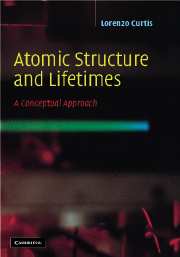Book contents
- Frontmatter
- Contents
- Preface
- List of physical constants and useful interrelations
- 1 Introduction
- 2 Semiclassical conceptual models
- 3 Semiempirical parametrization of energy-level data
- 4 The vector model of angular momentum
- 5 The intermediate coupling model
- 6 Electric dipole radiation
- 7 Line strengths in two-valence-electron systems
- 8 Magnetic dipole transitions
- 9 Absorption of radiation
- 10 Time-resolved measurements
- 11 Hyperfine structure
- 12 Electrostatic polarizabilities and long-range interactions
- 13 Coherence and anisotropic excitation
- References
- Index
11 - Hyperfine structure
Published online by Cambridge University Press: 06 July 2010
- Frontmatter
- Contents
- Preface
- List of physical constants and useful interrelations
- 1 Introduction
- 2 Semiclassical conceptual models
- 3 Semiempirical parametrization of energy-level data
- 4 The vector model of angular momentum
- 5 The intermediate coupling model
- 6 Electric dipole radiation
- 7 Line strengths in two-valence-electron systems
- 8 Magnetic dipole transitions
- 9 Absorption of radiation
- 10 Time-resolved measurements
- 11 Hyperfine structure
- 12 Electrostatic polarizabilities and long-range interactions
- 13 Coherence and anisotropic excitation
- References
- Index
Summary
To find meaning, I looked inside the atom, and found it almost empty.
Atomic interactions are usually described in terms of three different types of interactions. The gross structure refers to the predictions of the Kepler–Coulomb–Schrödinger nonrelativistic electrostatic model in which the electron moves in a simple 1/r central potential. The fine structure refers to the relativistic correction to that picture due to: the relativistic momentum; various interactions between the magnetic moment of the electron with that of other electrons; and the relative motion of the static charge of the nucleus. The quantum electrodynamic corrections due to the interaction of the electron with the radiation field are often included with the fine structure. The hyperfine structure refers to a general class of interactions that arise as a result of the finite mass, size, charge distribution, and charge circulation of the nucleus.
The origins of hyperfine structure observations
Hyperfine structure was discovered by Albert A. Michelson in what might be called the second disappointment of the Michelson interferometer. Precision optical measurements were Michelson's lifelong passion, as evidenced by his pursuit of additional significant digits in the value for the speed of light. He began this quest in 1878, and by 1882 had a value good to within 0.02 percent. In 1926 he improved that measurement to just over one part in 105.
In 1881 Michelson began the construction of his “interferential refractometer” (the Michelson interferometer) in the hope of making a precision measurement of the motion of the Earth through the imagined luminiferous aether. The results of this attempt (jointly with Edward W. Morley) were declared a “failure” in 1887.
- Type
- Chapter
- Information
- Atomic Structure and LifetimesA Conceptual Approach, pp. 207 - 219Publisher: Cambridge University PressPrint publication year: 2003



